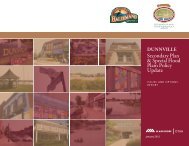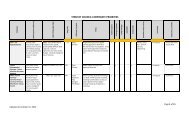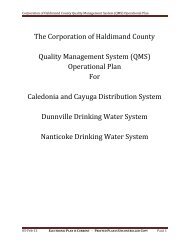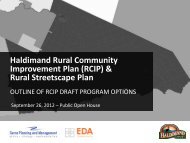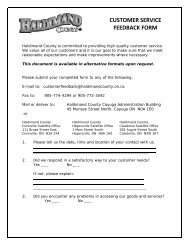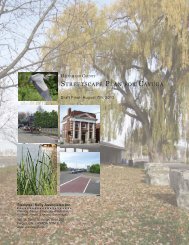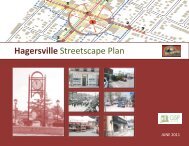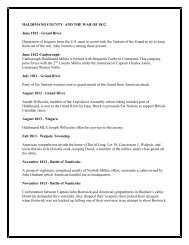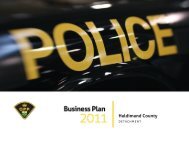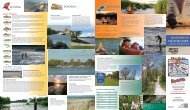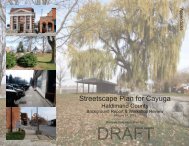Dunnville Secondary Plan - Urban Design Guide - Haldimand County
Dunnville Secondary Plan - Urban Design Guide - Haldimand County
Dunnville Secondary Plan - Urban Design Guide - Haldimand County
- No tags were found...
You also want an ePaper? Increase the reach of your titles
YUMPU automatically turns print PDFs into web optimized ePapers that Google loves.
5 / Public Realm <strong>Guide</strong>lines<br />
5.1 Develop Complete Streets<br />
The pedestrian environment refers to the structure,<br />
setting and support for public life in urban settings.<br />
A public realm that is well proportioned, connected,<br />
legible, comfortable, safe and attractive, contributes<br />
to the quality of life for all citizens. Improvements<br />
for pedestrians should focus on increasing space<br />
to support social and retail activities, providing<br />
visual relief in an urban setting, and elevating<br />
environmental quality.<br />
It is often assumed that the main purpose of streets<br />
is to accommodate the movement of vehicles and<br />
to provide for the routing of public utility lines. Most<br />
current standards and criteria for the design of<br />
streets reflect those priorities.<br />
Beyond their utilitarian purposes, streets have many<br />
other, equally important dimensions. Streets are<br />
highly valued civic spaces as settings for public<br />
social life and activity. The best, most popular and<br />
thriving main streets are where there are narrow–<br />
fronted shops and transparent display windows and<br />
entrances, set back sufficiently from the roadway<br />
to allow for canopies, street trees and furniture,<br />
and room for boulevard window shopping, outdoor<br />
eating and merchandizing, as well as the circulation<br />
of passing pedestrians. Parked vehicles at curbside<br />
also help to insulate walkers from moving traffic.<br />
This typifies the historic <strong>Dunnville</strong> downtown.<br />
The best local residential streets are intimate in<br />
scale and detail, allowing residents to live at a<br />
slower pace. Buildings are appropriately designed<br />
and set back further from the roadway with lushly<br />
planted and well-maintained front yards. Traffic<br />
is slower, providing a higher sense of safety for<br />
cyclists and pedestrians.<br />
5.1.1 Create an attractive and effective<br />
pedestrian environment<br />
Streets are public spaces that should be seen<br />
as ‘urban rooms’ with floors, walls, ceilings or<br />
canopies, and furnishings. The quality of this space<br />
relies heavily on the attention given to the design,<br />
landscaping, materials and finishes applied to the<br />
area that is closest to the pedestrian.<br />
<strong>Guide</strong>lines<br />
• Sidewalks should be designed with coherent<br />
street walls, street trees, and other elements that<br />
give enclosure to the street spaces.<br />
• Clear (and possibly subtle) indications should be<br />
provided to delineate between public and private<br />
spaces, in the choice of paving, walls, steps,<br />
materials, plantings, etc.<br />
• Pedestrian scale lighting at appropriate locations<br />
and well-designed street furniture including<br />
benches, garbage receptacles and bicycle<br />
parking facilities should be incorporated into the<br />
design of pedestrian spaces.<br />
20 / <strong>Dunnville</strong> <strong>Secondary</strong> <strong>Plan</strong> and Special Flood Plain Policy Update <strong>Urban</strong> <strong>Design</strong> <strong>Guide</strong>lines



